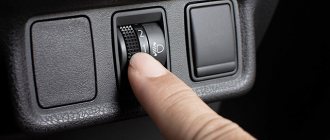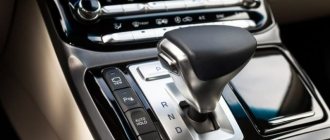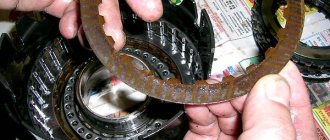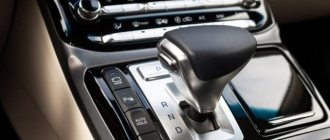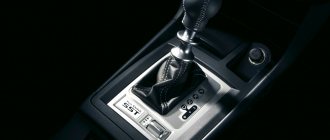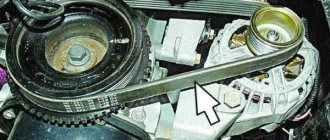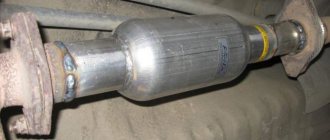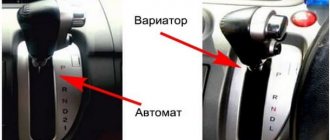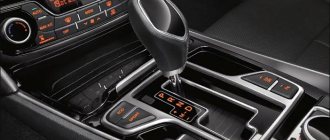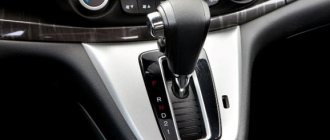As you know, automatic transmissions are widely used today. Moreover, the modern automobile industry offers a large selection of different types of automatic and semi-automatic transmissions (“classic” hydromechanical automatic transmissions, CVT variators, automatic manual transmissions such as AMT and preselective dual-clutch transmissions).
Each type of automatic transmission differs from each other in design and operating principles, but manufacturers strive to make all boxes similar in terms of functionality. In practice, this means that two completely different units can have similar functions and operating modes (for example, many automatic transmissions and DSGs have a Tiptronic mode, etc.).
At the same time, even despite the attempts of manufacturers to simplify the overall process of interaction with the automatic transmission selector as much as possible, owners still encounter difficulties. Often, when changing to a car with an automatic transmission, drivers do not know the purpose of certain additional modes, function buttons, etc.
In this article we will talk about what the button on the automatic transmission lever is needed for and what it is responsible for, as well as what other additional buttons can be found on the selector lever of various automatic transmissions.
List of situational moments that require turning on the button
However, if the automatic transmission has gone into emergency mode or the engine has stalled in the middle of a busy highway, you can safely use Shift Lock to, for example, set the rocker to the neutral position. It will be easier for another car to tow your box without harm if there is no tow truck nearby.
Read
Typical problems and repairs of automatic transmission f4a42
Now I will describe situations in which the use of “Shift Lock” on an automatic transmission will be useful to you:
- stopping at a gas station;
- car breakdown requiring towing, as I wrote above;
- stopping in front of the turnstile to deposit money.
Thanks to this key, you can always unlock the automatic transmission and put the rocker in the desired position. By the way, on old boxes, instead of a key, the driver found a hole for the key. The key acted as a “Shift Lock” unlocker, by inserting which it was also possible to change the position of the selector lever on a locked automatic transmission.
Read also: Free templates for Instagram
Overdrive
The automotive industry produces several types of automatic transmissions. These are robotic gearboxes, CVTs, preselective robots with two clutches, as well as hydromechanical automatic transmissions, which are the most common. They have 4 or 6 steps.
Such boxes usually have several selector positions, namely D, R, N and P. The first is “Drive”, which is used while driving, the others are “Reverse”, “Neutral” and “Parking”, which is activated when the car is parked . If you study the console in more detail, you will notice slots for manual mode with “-” and “+” signs, where you can forcefully change gears. However, on old boxes there is another button that is not very noticeable and is sometimes hardly used by the owners. This is an OD (Overdrive) function.
The OD button is usually located outside the selector and placed on the central tunnel, so it is little associated with the operation of an automatic transmission. It is small in size and sometimes marked with a snowflake, hinting that it is recommended to use the OD mode in winter, when the roads are covered with snow. This function allows the box not to go to the highest level and always operate at engine speeds in the range of 2-4 thousand, which makes it possible to always keep the engine at maximum torque. When OD mode is engaged, the 4-speed automatic transmission simply will not shift above 3rd gear. In slushy snow, extra Newton meters won't hurt. High revs also help to effectively brake the engine when releasing the gas.
Question answer
How to slip correctly on an automatic transmission?
The OD button is not always placed directly on the tunnel. Often it is placed on the gearbox lever in some inconspicuous place on the side or bottom of the selector. It is also possible that the automatic transmission does not have an overdrive program at all. On many modern cars it is replaced by a sport mode, which also maintains lower transmission levels for a long time.
What is Shift Lock Release on an automatic transmission?
It is impossible to figure out the purpose of this dig on your own using an experimental method. When you press it, you cannot notice visible changes in the operation of the engine and other components. Ultimately, most owners simply do not attach importance to this key, yet it is very important, especially in emergency situations.
Literally, the name Shift Lock Release can be translated as: removing the transmission lock. How it works? Imagine a situation where the car’s engine has stalled or is turned off, and you need to tow or roll the car to the side of the road, roll it out of the garage, or do some other manipulation. If the automatic transmission handle was switched to forward driving mode or parking mode at the time of shutdown, then it will not be possible to move the car. There is not enough strength to push it away manually. When you try to tow, you can completely damage the box by jamming it and asking for major repairs.
Manu
Alternative names: Hold, ETC Snow, Snow, current gear lock switch. When pressed, the currently selected gear is blocked from downshifting or upshifting, and a warning lamp in the instrument cluster lights up.
The button can be used in conjunction with the “D” mode and a manually selected gear – values 1, 2, 3, L on the mode scale.
In the first case, the car will start from 2nd gear. This will avoid slipping on ice and snow. In the second case, it makes it easier to climb/overtake and allows you to effectively use engine braking on steep descents, preventing overheating of the brake system elements and saving their life.
Purpose of the shift lock button
Indeed, understanding the purpose of the device is not easy; the average user is used to checking the functionality in practice. Compared to other automatic transmission buttons, activating the “shift lock” does not make any changes in the behavior of the car and this leads to a dead end.
Turning on the mechanism does not bring a tangible result, pressing is not displayed on the information display, there is no response in the form of a sound signal, changes in the behavior of vehicles in motion, etc. The situation is aggravated by the lack of information in the instructions on some car models.
The button is shown schematically, but the description and procedure for activation is missing.
More about Nissan: Raccoon motorcycle trailer (yellow)
“Shift lock” button (cue):
In fact, the situation is simple, the “shift lock” button on the gearbox is designed to unlock the lever when the power plant is turned off.
Leaving the car in “P” (parking) mode, the driver turns on the automatic locking, which prevents the lever from accidentally or inadvertently switching to reverse mode.
The measure prevents an emergency situation that is possible when a car rolls away while standing on an uneven surface.
The opposite situation also happens. For example, driving a car with a dead battery and parking poorly, the driver will block the passage of other vehicles.
It is not possible to start the engine, since the “P” mode does not allow the lever to be switched to the neutral position. This is where the “shift lock release” button comes in handy.
It is worth noting that there are many options when a function can help out; for this reason, every driver is obliged to study the instructions for the box in use in advance.
Engine VAZ 11183 - Technical characteristics and modifications
Removing the plug:
Important! Using the button, the lever is moved to the neutral position for further movement of the vehicle; it is not recommended to use the function for towing vehicles. Otherwise, there is a high probability of damage to the automatic transmission.
Power
Alternative names – Sport, ETC PWR. When turned on, the gear buttons shift at high engine speeds, and the corresponding indicator on the instrument cluster turns on.
This mode is recommended for use on slopes on the highway, at speeds above 90 km/h. When pressed, the gear will decrease and the car will accelerate.
Main (large) button
The main large key is needed to change gears. Without pressing it, you will not be able to change gears on an automatic transmission. On my AVEO, this button is made in such a way that whether you want it or not, you have to press it.
Why such buttons for fixing the automatic transmission lever are needed, everything is simple - this is done so as not to accidentally move the selector to an unnecessary position, for example, if you hit it with your hand or dropped something, and a child might pull it. And if you suddenly shift the lever into reverse gear at speed, then it’s not far from a breakdown. This is what the main big button on the automatic transmission lever is for. In principle, this is elementary and everyone knows it.
O/D Off
The second name is Overdrive mode. By default it is disabled and blocks the use of higher gears. The mode status is displayed by a lamp on the instrument cluster or by the backlight of the button: on - off, off - on.
It is recommended to turn on the “Overdrive” mode when driving on the highway at speeds above 80 km/h. This will reduce fuel consumption by reducing the gear ratio between the primary and secondary gears, the engine speed required to maintain speed, and the consistency of the latter.
In the city, it is better not to turn on the mode, since the automatic transmission will often switch between direct and overdrive gears, reducing the life of moving parts.
How to use the shift lock button
Before using the button, it is recommended to study the documentation in detail. On some box models, the button is hidden under a plug that prevents accidental pressing.
Pressing a button to move the lever:
- Let's look at the procedure using the Toyota box as an example:
- Set the car to the parking brake;
- Remove the key from the ignition;
- Provide access to the shift lock release button, for which, take a screwdriver;
- Remove the plug using a screwdriver;
- Insert the ignition key into the resulting hole;
- Press the key while simultaneously moving the lever to the desired gear;
- Release the button, locking the lever in the desired gear;
- Remove the key, install the plug;
- Place the key in the ignition, press the brake pedal;
- Crank the engine.
Starting and stopping with automatic transmission
Most drivers who switch from a manual to an automatic transmission initially automatically perform actions that they are accustomed to performing repeatedly when driving a car with a manual transmission. Therefore, before starting to drive with an automatic transmission on the road in general traffic, such drivers are advised to first practice alone.
So, the standard procedure for starting a car with an automatic transmission is as follows:
- Insert the key into the ignition.
- Depress the brake pedal with your right foot (the left foot is not used when driving with an automatic transmission).
- Check the position of the gear shift lever - it should be in the “P” - “parking” position.
- Start the engine (with the brake pedal pressed).
- Also, with the brake pedal pressed, switch the PP lever to position “D” - “drive” (moving forward).
- Fully release the brake pedal, after which the car will move off and begin to move forward at a low speed - about 5 km/h.
- To increase the speed, you need to press the gas pedal. The harder you press the gas pedal, the higher the gears and speed will be.
- To stop the car, you need to remove your right foot from the gas pedal and press the brake pedal. The car will stop.
- If you plan to leave the car after stopping, then with the brake pedal pressed, move the gear lever to the “P” - “parking” mode. If you need to stop in a traffic jam, at a traffic light or a pedestrian crossing, then, naturally, there is no need to switch the PP lever to “parking”. Once you decide to continue driving again, release the brake pedal and press the gas pedal to increase speed.
Many modern automatic transmissions have an imitation of the mechanical gear shift mode “M” (as on a manual transmission) for up/down gears using the “+” and “–” buttons on the gearshift lever. That is, the driver is given the opportunity to manually increase or decrease gears, taking away this function from the “automatic”. In this case, the transition to a mechanical gear shift mode can be made while driving, when the car is already driving in “D” mode.
To prevent engine damage when switching to manual mode “M” while driving, all automatic transmissions have special protection. Switching to manual control “M” is relevant in the following situations:
- When driving off-road, use a lower gear to avoid slipping.
- When coasting down a hill, with engine braking. It is not recommended to use the neutral “N” mode for coasting, as it is harmful to the automatic transmission. And coasting in “D” mode is not entirely convenient, since there is a gradual decrease in speed.
- For comfortable cornering and other maneuvers, including sharp acceleration when overtaking.
Designations (symbols) on the automatic transmission panel
To learn how to use an automatic transmission correctly, you first need to understand what the alphabetic symbols (English letters) and numbers on the automatic transmission panel with the gear shift knob mean. Let us immediately note that depending on the brand of car, numbers and letters may vary.
- “P”
– “parking”. It turns on when the car is parked in a parking lot. A kind of analogue of a parking brake, only with the shaft blocked, and not with the brake pads pressed. - "R"
- "reverse". Turns on for reverse movement. It is usually called “reverse speed”. - “N”
– “neutral”. Neutral gear. Often called “neutral”. Unlike the “P” parking mode, in the neutral “N” mode the wheels are unlocked, so the car can coast. Accordingly, the car can also spontaneously roll downhill in a parking lot if the wheels are not secured with a hand brake. - "D"
- "drive". Forward mode. - "A"
- "automatic". Automatic mode (practically the same as “D” mode). - “L”
– “low” (low). Low gear mode. - "B"
- Same mode as "L". - «2»
– driving mode is not higher than second gear. - «3»
– driving mode is not higher than third gear. - "M"
- "manual". Manual control mode with up/down gear through the “+” and “–” signs. This mode simulates the mechanical shift mode with a manual transmission, only in a simpler version. - "S"
- "sport". Sports driving mode. - "OD"
- "overdrive". Upshift (overdrive mode). - "W"
- "winter". Driving mode for the winter period, in which starting from a standstill begins in second gear. - "E"
- "Economy". Driving in economy mode. - "HOLD"
- "hold". Used in conjunction with “D”, “L”, “S”, as a rule, on Mazda cars. (Read manual).
When operating an automatic transmission, special attention should be paid to studying the operating manual for a particular vehicle, since some symbols may differ functionally.
For example, in the manuals of some cars, the letter “B” means “Block” - a differential locking mode that cannot be engaged while driving.
And if an all-wheel drive car has the designations “1” and “L”, then the letter “L” may not mean “Low” (lowering), but “Lock”
(lock) – which also means differential lock.
Rules for proper use
Automatic transmission cutaway
Every owner of a car with an automatic transmission needs to know how to properly operate an automatic transmission:
- The main advice for driving an automatic transmission is that the automatic transmission does not tolerate any kind of wheel slip. This rule is especially relevant in winter, when there is a lot of snow or ice around; at this time you need to drive your car carefully. The same rule applies to drivers - racers who like to drive with slippage even on dry asphalt. Today's cars are often equipped with various traction control systems, and this is very necessary for automatic transmissions. But sometimes this system needs to be turned off (for example, when your car is stuck). It is impossible to completely disable the wheel slip system, but you can reduce its impact to a minimum.
- When driving an automatic transmission, you cannot engage neutral gear without good reason. This mode cannot be abused on an automatic transmission. This mode is considered to be “service” and is needed to drive without turning on the engine.
- There is no need to tow a vehicle with an automatic transmission, a trailer or another vehicle. The machine is simply not suitable for this. Of course, any transmission has a certain reserve of strength and your car will not break down right away, however, systematic driving with heavy loads will endlessly bring a serious automatic transmission malfunction closer. If you are going to use a trailer very often in a car with an automatic transmission, choose a car that has a significant margin of safety from the very beginning. For example, a powerful jeep. The box of such a car is designed for the considerable weight of the jeep itself, as a result of which the weight of the trailer itself will have a slight impact on the automatic transmission.
- Not . Certain drivers, of course, sometimes push-start cars with automatic transmissions, but this will eventually lead to the transmission breaking down.
- Under no circumstances should a car with an automatic transmission be towed while tied. This is the worst thing that can be done to an automatic transmission. It is associated with the fact that transmission fluid must continuously circulate in the box while driving. If the car’s engine is turned off, the automatic transmission is not properly lubricated and this will certainly harm it. The practical manual for operating the gearbox states that towing is possible over short distances, up to twenty to fifty kilometers, at a speed of no more than 20-30 km/h. However, in practice, if the service station is located further than 3-5 km, it is preferable to use the services of a tow truck. Payment for services for a tow truck will not be very high, but serious consequences for the automatic transmission can be completely avoided.
Apart from this, we must not forget that an automatic transmission is an extremely complex device that requires timely maintenance and replacement of transmission fluid. The service must be carried out on time, and in driving conditions on our roads before it occurs. If you take into account all our recommendations, the box will serve you long and reliably.
What do the letters on the automatic transmission box mean (P, D, N, R and M)
Selector lever position in P (Parking)
turns on the parking mode, that is, long-term parking, during which the box blocks the movement of the car. In this mode, engine starting is allowed. When parking your vehicle on a slope, you must first apply the parking brake.
Position D (Drive)
- also sometimes designated
A (Automate)
- is the main mode of forward movement of the car with automatic gear shifting under normal conditions. The same mode remains on during short stops, when there is no need to turn off the engine, for example at a traffic light.
R (Reverse)
turns on the reverse driving mode.
The so-called “neutral” N (Neutral)
on the machine is intended mainly for towing the car, or similar service transportation, when it becomes necessary to completely disconnect the engine from the wheels.
In this position, the output shaft of the box is unlocked and the car is not controlled by the transmission, that is, it can move freely. In this mode, engine starting is allowed, and you can put the gearbox on it when parking with the handbrake on, although in this case it is still more convenient to put the selector on P (Parking)
.
Kickdown
Automatic boxes, especially old ones, have another button, which often saves lives. However, it is so well hidden that it is almost impossible to find it without a good knowledge of the hardware. This is the Kickdown button, and it is located under the driver’s feet, behind the accelerator pedal.
The button is embedded in the floor and is pressed not by the foot, but by the stiffening rib from the pedal when pushing it all the way. When the button is activated, the automatic switches to extreme mode, drops a couple of gears down, spins the engine to the red zone, and on a number of cars even changes the mixture preparation process in order to breathe maximum power into the engine. This is required for instant acceleration in order to avoid an emergency situation. Sometimes Kickdown allows you to very quickly dodge an out-of-control truck or avoid an intersection.
On modern automatic transmissions, Kickdown has been replaced with a software analogue. When you sharply press the gas pedal, the control unit launches a new engine and gearbox control program for maximum acceleration.
Let's sum it up
As you can see, on most selectors, the button on the automatic transmission handle is a “block” from accidental activation of modes and gears. Typically, such a button is located so that it is as convenient as possible for the driver to press it when manipulating the lever.
In some cases, this arrangement greatly facilitates the process of driving a car with an automatic transmission, allowing you to quickly enable or disable one or another mode.
Features of the operation of automatic transmissions: the correct choice of modes, restrictions and recommendations on how to properly drive a car with an automatic transmission.
Tiptronic mode of automatic transmission: purpose, operating principle of Tiptronic. Advantages and disadvantages of Tiptronic automatic transmission.
Mode “S” on an automatic transmission: what is the sport mode for? How to use the “S” sport mode on an automatic transmission, what you need to consider.
Operation of a CVT gearbox: features of driving a car with a CVT, maintenance of a CVT gearbox. Useful tips and tricks.
Numbers and letters on the automatic transmission: designation of automatic transmission modes. What are the automatic transmission modes for, how and when to turn on the main and additional modes.
Source
